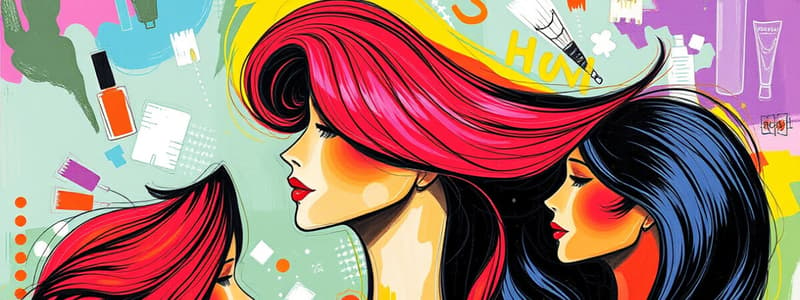Podcast
Questions and Answers
What are reference points and what is their function?
What are reference points and what is their function?
Surface changes in the head; finding the right balance in a design.
What are lines, sections, elevations, and guidelines?
What are lines, sections, elevations, and guidelines?
Lines are continuous marks used as a guide; sections are working areas of the hair; elevations are the degree at which hair is lifted; guidelines are sections of hair that determine the length.
What are important considerations to discuss with the client during a haircutting consultation?
What are important considerations to discuss with the client during a haircutting consultation?
Their lifestyle, how much effort they want to put into their hair, what they like.
What are razor haircutting shears, styling or cutting comb, and texturizing shears used for?
What are razor haircutting shears, styling or cutting comb, and texturizing shears used for?
What are three things you can do to ensure good posture and body position while cutting hair?
What are three things you can do to ensure good posture and body position while cutting hair?
Name and describe the 4 basic types of haircuts.
Name and describe the 4 basic types of haircuts.
What is another name for bangs? When should you avoid cutting bangs? Name 5 basic types of bangs.
What is another name for bangs? When should you avoid cutting bangs? Name 5 basic types of bangs.
Name and describe 3 or more texturizing techniques performed with shears.
Name and describe 3 or more texturizing techniques performed with shears.
What is a clipper cut?
What is a clipper cut?
How is a trimmer used?
How is a trimmer used?
Flashcards are hidden until you start studying
Study Notes
Reference Points
- Serve as surface changes in the head to help find balance in a hairstyle.
Lines, Sections, Elevations, and Guidelines
- Lines: Continuous marks, can be straight or curved; may be horizontal, vertical, or diagonal.
- Sections: Defined working areas of hair during haircutting.
- Elevations: Also called projection or lifting; refers to the angle at which hair is lifted for cutting.
- Guidelines: Initial cut section that determines the overall length and shape of the haircut, found at the perimeter or interior.
Haircutting Consultation Considerations
- Discuss client's lifestyle, maintenance preferences, and personal likes to tailor the haircut.
Hair Cutting Tools
- Razor: Used for creating soft, textured ends and layers.
- Shears: For precise cutting and shaping of hair.
- Styling or Cutting Comb: Essential for sectioning and guiding hair during cuts.
- Texturizing Shears: Used to remove weight and create texture without changing the overall length.
Good Posture and Body Position
- Position the client for comfort and accessibility.
- Center your weight for balance while cutting.
- Maintain a position in front of your section to ensure accuracy.
Basic Types of Haircuts
- Blunt: A straight cut across the bottom.
- 45°: Bob cut, elevating hair to create a slight angle.
- 90°: Shaggy layers for a textured look.
- 180°: Long layered haircut, offering significant volume.
Bangs
- Also known as fringe; best avoided on clients with strong cowlicks or low hairlines.
- Types of Bangs:
- Asymmetric Bang: Uneven lengths for a trendy look.
- Side-Swept Bang: Soft, tapered bangs that slant to one side.
- Versatile Bang: Can be styled in multiple ways.
- Short Textured Bang: Short and choppy for a modern effect.
- Square Bang: Straight-across cut for a bold statement.
Texturizing Techniques
- Carving: Involves placing the blade against the scalp and moving it with partial openings to create texture.
- Effilating: Slithering technique to thin hair to varying lengths using a sliding motion.
- Free-Hand Notching: Randomly snipping sections of hair to achieve a more dynamic texture.
Clipper Cut
- Hair is closely cropped on the bottom and sides, gradually increasing in length toward the crown for a blended effect.
Trimmer Use
- Used for creating clean lines around the ears; employ both hands for control and arc the trim around the ear while securing hair with a comb.
Studying That Suits You
Use AI to generate personalized quizzes and flashcards to suit your learning preferences.




